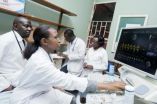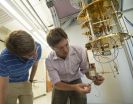(Press-News.org) Research at New York University is paving the way for a breakthrough that may prevent brain damage in civilians and military troops exposed to poisonous chemicals—particularly those in pesticides and chemical weapons.
An article in the current issue of the journal ChemBioChem outlines the advancement in detoxifying organophosphates, which are compounds commonly used in pesticides and warfare agents. The patent-pending process was developed by NYU School of Engineering Associate Professor of Chemical and Biological Engineering Jin Kim Montclare, along with Richard Bonneau, an associate professor in NYU's Department of Biology and a member of the computer science faculty at NYU's Courant Institute of Mathematical Sciences.
Their work centers on proteins called phosphotriesterases, which have the unique capability of degrading chemicals in a class known as organophosphates, which are found in everything from industrial pesticides to the sarin gas used in chemical warfare.
Organophosphates permanently bond to neurotransmitters in the brain, interfering with their ability to function and causing irreversible damage. The ability of phosphotriesterases to detoxify organophosphates has been previously documented; however, applications using the protein for this purpose have been limited by its short half-life and instability at high temperatures.
Montclare and her colleagues devised a method of re-engineering phosphotriesterases by incorporating an artificial fluorinated amino acid and computational biology. The result: a thermo-stable protein with a longer half-life that retains all the detoxification capabilities of the original version.
"Organophosphates pose tremendous danger to people and wildlife, and sadly it's not unusual for humans to come into contact with these compounds, whether through exposure to pesticide or an intentional chemical warfare attack," explained Montclare. "We've known that phosphotriesterases had the power to detoxify these nerve agents, but they were far too fragile to be used therapeutically," she said.
In a process that married computational biology and experimentation, the collaborators used Rosetta computational modeling software to identify sequences in the fluorinated phosphotriesterase protein that could be modified to increase its stability and make therapeutic applications a reality.
The possibilities for this reengineered protein are considerable. Montclare explained that in addition to therapeutic formulations, which could prevent nerve damage in the event of a gas attack or pesticide exposure and would likely be developed first for military use, the proteins could be critical when stores of toxic nerve agents need to be decommissioned.
"Oftentimes, chemical agent stockpiles are decommissioned through processes that involve treatment with heat and caustic chemical reagents for neutralization, followed by hazardous materials disposal," she said. "These proteins could accomplish that same task enzymatically, without the need for reactors and formation of dangerous byproducts."
Plans are under way to begin developing therapeutic applications for this modified phosphotriesterase, and the research team believes that its methodology—using computational biology to identify potentially beneficial modifications to proteins—could point the way to future breakthroughs in engineered proteins.
INFORMATION:
The initial idea for this work was broached by Michelle Zhang, a co-author of the paper and, at the time, a high school intern in Bonneau's lab. Zhang is now a student at Cornell University. Other collaborators include NYU School of Engineering doctoral students Andrew J. Olsen, Ching-Yao Yang, and Carlo Yuvienco; and P. Douglas Renfrew, a postdoctoral scholar in the Bonneau Laboratory at NYU.
Research was supported by a grant from the U.S. Army Research Office and the National Science Foundation. The full paper, Improved Stability and Half-life of Fluorinated Phosphotriesterase Using Rosetta, is available at http://onlinelibrary.wiley.com/doi/10.1002/cbic.201402062/full.
The NYU Polytechnic School of Engineering dates to 1854, when the NYU School of Civil Engineering and Architecture as well as the Brooklyn Collegiate and Polytechnic Institute (widely known as Brooklyn Poly) were founded. Their successor institutions merged in January 2014 to create a comprehensive school of education and research in engineering and applied sciences, rooted in a tradition of invention, innovation and entrepreneurship. In addition to programs at its main campus in downtown Brooklyn, it is closely connected to engineering programs in NYU Abu Dhabi and NYU Shanghai, and it operates business incubators in downtown Manhattan and Brooklyn. For more information, visit http://engineering.nyu.edu.
Engineering a protein to prevent brain damage from toxic agents
NYU researchers advance the stability of a protein that neutralizes toxins in common pesticides and chemical weapons
2014-07-31
ELSE PRESS RELEASES FROM THIS DATE:
Transplantation shown to be highly effective in treating immune deficiency in children
2014-07-31
Babies who are born with severe combined immunodeficiency (SCID) can be successfully treated with a transplant of blood-forming stem cells, according to experts led by Memorial Sloan Kettering's Richard J. O'Reilly, MD, a world-renowned pioneer in the development of transplant protocols. Their review will be published in the July 30 issue of the New England Journal of Medicine.
SCID is a group of inherited disorders that cause the immune system to severely malfunction. When this breakdown occurs, babies no longer have the ability to fight off routine infections because ...
Journal supplement details progress in African medical education
2014-07-31
Medical education in sub-Saharan Africa is being revitalized and expanded through a U.S.-funded effort that is dramatically increasing enrollment, broadening curricula, upgrading Internet access and providing cutting-edge skills labs and other technologies.
In the first substantial publication by participants of the $130 million Medical Education Partnership Initiative (MEPI), more than 225 authors detailed progress being made at the African institutions. Their reports are in a supplement being published today by the journal Academic Medicine. Begun in 2010, MEPI is ...
Resistance to key malaria drug spreading at alarming rate in Southeast Asia
2014-07-31
WHAT:
Resistance to artemisinin, the main drug to treat malaria, is now widespread throughout Southeast Asia, among the Plasmodium falciparum (P. falciparum) parasites that cause the disease and is likely caused by a genetic mutation in the parasites. However, a six-day course of artemisinin-based combination therapy—as opposed to a standard three-day course—has proved highly effective in treating drug-resistant malaria cases, according to findings published today in the New England Journal of Medicine. The research was conducted by an international team of scientists ...
Biologists describe mechanism promoting multiple DNA mutations
2014-07-30
DNA mutations—long known to fuel cancer as well as evolutionary changes in a living organism—had been thought to be rare events that occur randomly throughout the genome.
However, recent studies have shown that cancer development frequently involves the formation of multiple mutations that arise simultaneously and in close proximity to each other. These groups of clustered mutations are frequently found in regions where chromosomal rearrangements take place.
The discovery, published in the journal Cell Reports, may one day lead to new cancer therapies, according to ...
Classic Lewis Carroll character inspires new ecological model
2014-07-30
Inspired by the Red Queen in Lewis Carroll's Through the Looking Glass, collaborators from the University of Illinois and National University of Singapore improved a 35-year-old ecology model to better understand how species evolve over decades to millions of years.
The new model, called a mean field model for competition, incorporates the "Red Queen Effect," an evolutionary hypothesis introduced by Lee Van Valen in the 1970s, which suggests that organisms must constantly increase their fitness (or ability to survive and reproduce) in order to compete with other ever-evolving ...
Diverticulitis patients reveal psychological, physical symptoms long after acute attacks
2014-07-30
UCLA researchers interviewed people with diverticulitis and confirmed that many suffer psychological and physical symptoms long after their acute illness has passed.
For the study, published this week in the peer-reviewed journal Quality of Life Research, a UCLA team led by Dr. Brennan Spiegel interviewed patients in great detail about the symptoms they experience weeks, months or even years after an acute diverticulitis attack. Their striking findings add to growing evidence that, for some patients, diverticulitis goes beyond isolated attacks and can lead to a chronic ...
Finding quantum lines of desire
2014-07-30
Groundskeepers and landscapers hate them, but there is no fighting them. Called desire paths, social trails or goat tracks, they are the unofficial shortcuts people create between two locations when the purpose-built path doesn't take them where they want to go.
There's a similar concept in classical physics called the "path of least action." If you throw a softball to a friend, the ball traces a parabola through space. It doesn't follow a serpentine path or loop the loop because those paths have higher "actions" than the true path.
But what paths do quantum particles, ...
Tidal forces gave moon its shape, according to new analysis
2014-07-30
The shape of the moon deviates from a simple sphere in ways that scientists have struggled to explain. A new study by researchers at UC Santa Cruz shows that most of the moon's overall shape can be explained by taking into account tidal effects acting early in the moon's history.
The results, published July 30 in Nature, provide insights into the moon's early history, its orbital evolution, and its current orientation in the sky, according to lead author Ian Garrick-Bethell, assistant professor of Earth and planetary sciences at UC Santa Cruz.
As the moon cooled and ...
Target growth-driving cells within tumors, not fastest-proliferating cells
2014-07-30
BOSTON –– Of the many sub-groups of cells jockeying for supremacy within a cancerous tumor, the most dangerous may not be those that can proliferate the fastest, researchers at Dana-Farber Cancer Institute report in a paper appearing in an advance online publication of the journal Nature. The findings have important implications for the treatment of cancer with precision medicines, the study authors explained: Doctors need to ascertain which cell subgroups are truly driving the tumor's growth and metastasis and select drugs that target the critical genes within those cells. ...
ALMA finds double star with weird and wild planet-forming discs
2014-07-30
BOWLING GREEN, O.—From movies to television, obesity is still considered "fair game" for jokes and ridicule. A new study from researchers at Bowling Green State University took a closer look at weight-related humor to see if anti-fat attitudes played into a person's appreciation or distaste for fat humor in the media.
"Weight-Related Humor in the Media: Appreciation, Distaste and Anti-Fat Attitudes," by psychology Ph.D. candidate Jacob Burmeister and Dr. Robert Carels, professor of psychology, is featured in the June issue of Psychology of Popular Media Culture.
Carels ...
LAST 30 PRESS RELEASES:
Interaction of climate change and human activity and its impact on plant diversity in Qinghai-Tibet plateau
From addressing uncertainty to national strategy: an interpretation of Professor Lim Siong Guan’s views
Clinical trials on AI language model use in digestive healthcare
Scientists improve robotic visual–inertial trajectory localization accuracy using cross-modal interaction and selection techniques
Correlation between cancer cachexia and immune-related adverse events in HCC
Human adipose tissue: a new source for functional organoids
Metro lines double as freight highways during off-peak hours, Beijing study shows
Biomedical functions and applications of nanomaterials in tumor diagnosis and treatment: perspectives from ophthalmic oncology
3D imaging unveils how passivation improves perovskite solar cell performance
Enriching framework Al sites in 8-membered rings of Cu-SSZ-39 zeolite to enhance low-temperature ammonia selective catalytic reduction performance
AI-powered RNA drug development: a new frontier in therapeutics
Decoupling the HOR enhancement on PtRu: Dynamically matching interfacial water to reaction coordinates
Sulfur isn’t poisonous when it synergistically acts with phosphine in olefins hydroformylation
URI researchers uncover molecular mechanisms behind speciation in corals
Chitin based carbon aerogel offers a cleaner way to store thermal energy
Tracing hidden sources of nitrate pollution in rapidly changing rural urban landscapes
Viruses on plastic pollution may quietly accelerate the spread of antibiotic resistance
Three UH Rainbow Babies & Children’s faculty elected to prestigious American Pediatric Society
Tunnel resilience models unveiled to aid post-earthquake recovery
Satellite communication systems: the future of 5G/6G connectivity
Space computing power networks: a new frontier for satellite technologies
Experiments advance potential of protein that makes hydrogen sulfide as a therapeutic target for Alzheimer’s disease
Examining private equity’s role in fertility care
Current Molecular Pharmacology achieves a landmark: real-time CiteScore advances to 7.2
Skeletal muscle epigenetic clocks developed using postmortem tissue from an Asian population
Estimating unemployment rates with social media data
Climate policies can backfire by eroding “green” values, study finds
Too much screen time too soon? A*STAR study links infant screen exposure to brain changes and teen anxiety
Global psychiatry mourns Professor Dan Stein, visionary who transformed mental health science across Africa and beyond
KIST develops eco-friendly palladium recovery technology to safeguard resource security
[Press-News.org] Engineering a protein to prevent brain damage from toxic agentsNYU researchers advance the stability of a protein that neutralizes toxins in common pesticides and chemical weapons





